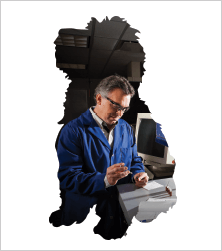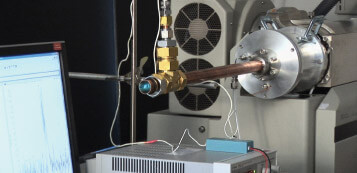A team at the Pacific Northwest National Laboratory (PNNL) has developed a new method that could revolutionize how explosives are detected, using ionization chemistry at the front end of a standard commercial mass spectrometer. Rather than collecting explosive particles by surface swipes for later analysis, the system samples air directly for explosive vapors at ambient temperature and pressure.
A team at the Pacific Northwest National Laboratory (PNNL) has developed a new method that could revolutionize how explosives are detected, using ionization chemistry at the front end of a standard commercial mass spectrometer. Rather than collecting explosive particles by surface swipes for later analysis, the system samples air directly for explosive vapors at ambient temperature and pressure. The new system easily detects vapors given off by a fingerprint-sized sample of RDX (Research Department Explosive), a low-volatility compound used in many explosives, at levels below 25 parts per quadrillion (1) - watch the video below to see the device in action.

Atmospheric pressure chemical ionization (APCI) is the key to the novel approach. Robert Ewing (pictured), a senior research scientist at PNNL, described how the chemistry was tailored to enhance ionization efficiency and selectivity for RDX. “Through the ionization process, a nitrate ion is formed – likely resulting from the production of ozone and NOx in the electrical discharge. The nitrate ion has a very high electron affinity and it is improbable that charge transfer will occur with other species. RDX is ionized by forming an adduct with the nitrate ion, whereas many other chemical species do not form such adducts, thus providing selective ionization for RDX”. Notably, the ionization also works well for other explosive compounds that can form similar adducts, such as pentaerythritol tetranitrate (PETN), nitroglycerine and tetryl. During development, the RDX vapors were ionized in a reaction region with a variable reaction time, which was controlled by either flow (atmospheric flow tube; AFT-MS) or an electric field (atmospheric drift tube; ADT-MS) in two different systems configurations. Each system gave similar, supporting results, but does one offer an advantage over the other? “The AFT-MS may provide a less complicated device wherein a small pump can be used for both sample collection and the movement of air to control reaction times,” says Ewing. With an eye on commercialization, Ewing has already started to think about moving from the experimental phase. “The major challenges in making the equipment portable and usable in the field are associated with the mass spectrometer; the size and power requirements of the pumping system may be the biggest hurdle since smaller pumps limit the orifice size and thus reduce sensitivity,” he notes. In the experimental system, a triple quadrupole MS was used to provide ion confirmation and additional selectivity. “The AB Sciex API-5000 is very sensitive to low ion currents resulting from the long reaction times used in the AFT or the ADT.” Moving forward, Ewing is confident that other triple quadrupole MS systems will also work well as long as they have sufficient pumping capacity and a small instrument footprint. “We will be actively engaged in integrating the vapor sampling technology with one such instrument through the end of this calendar year,” he says. Comparisons are unsurprisingly made to the canine olfactory system, but how sensitive must the system be to surpass those capabilities? “The sensitivity of canines is unknown – although they have been “sniffing” explosives for a long time... This work represents the first direct vapor detection of explosives so it should be comparable to the canine response. Further research in this area will be required,” concludes Ewing. Cost is another consideration entirely, but given the general downwards direction of MS system prices and the rising cost of dog ownership (2), the tipping point may well be in sight!

References
- R. G. Ewing, D. A. Atkinson, and B. H. Clowers, “Direct Real-Time Detection of RDX Vapors Under Ambient Conditions”, Analytical Chemistry 85 (1) 389–397 (2013). Author’s own experience.




